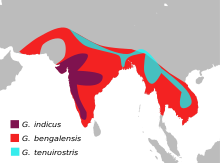| Indian vulture | |
|---|---|

| |
| Indian vulture | |
| Scientific classification | |
| Domain: | Eukaryota |
| Kingdom: | Animalia |
| Phylum: | Chordata |
| Class: | Aves |
| Order: | Accipitriformes |
| Family: | Accipitridae |
| Genus: | Gyps |
| Species: | G. indicus
|
| Binomial name | |
| Gyps indicus | |

| |
| Distribution in purple | |
The Indian vulture or long-billed vulture (Gyps indicus) is a bird of prey native to the Indian subcontinent. It is an Old World vulture belonging to the family of Accipitridae. It is a medium-sized vulture with a small, semi-bald head with little feathers, long beak, and wide dark colored wings. It breeds mainly on small cliffs and hilly crags in central India and south India.
The Indian vulture is a keystone species that has been listed as Critically Endangered on the IUCN Red List since 2002, as the population has severely declined during the Indian vulture crisis. It is estimated that there are 5,000-15,000 mature individuals in the wild. The main cause of the decline was identified as kidney failure caused by the drug diclofenac, which was commonly given to cattle to reduce joint pain. It is thought that diclofenac poisoned vultures that ate the flesh of dead cattle. Diclofenac bans were enacted in India, Pakistan and Nepal in 2006.
The bird shares its habitat with two other vulture species (namely, the slender-billed vulture (Gyps tenuirostris) and white-rumped vulture (Gyps bengalensis)) in some parts of its range.
- ^ BirdLife International (2021). "Gyps indicus". IUCN Red List of Threatened Species. 2021: e.T22729731A204672586. Retrieved 30 May 2022.
- ^ Scopoli, J. A. (1786–88). "Aves". Deliciae Flora et Fauna Insubricae Ticini. An account including new descriptions of the birds and mammals collected by Pierre Sonnerat on his voyages. London: C. J. Clay. pp. 7–18.
